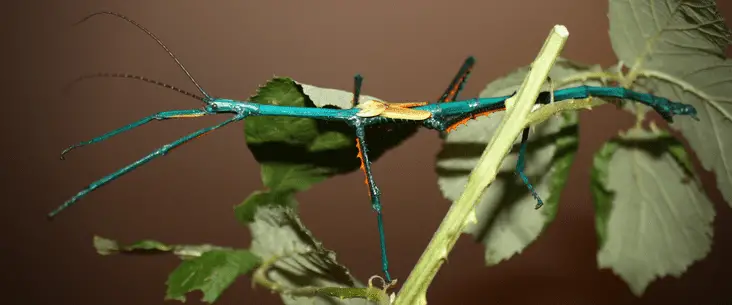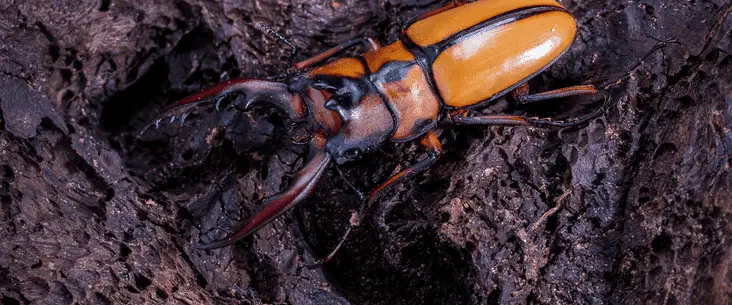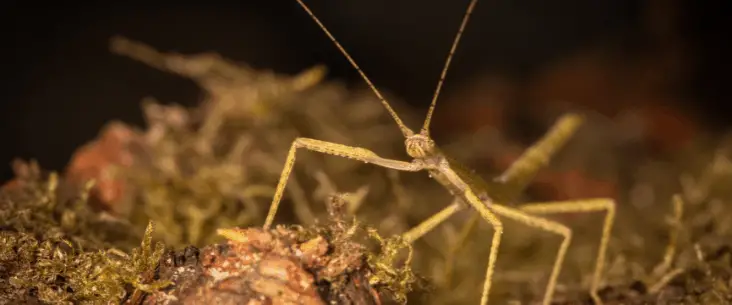Did you collect snails when you were a kid and kept them in a jar? Snails can be found everywhere and can easily be kept as pets. But the giant African land snail (Achatina achatina) is quite something else. These are real giants, some growing to more than 20cm (8″). But even due to their large size they can make wonderful pets and are very interesting to watch in their enclosure. In this guide, we will discuss how you can care for these magnificent (slimy) creatures. We will look at everything you should know to keep them: the housing, environmental conditions, feeding, cleaning and breeding of them. Become a real snail keeper!
Giant African land snails are easy to keep if you provide them with a fish tank with a good layer of substrate, fresh daily vegetables and proper environmental conditions. These snails like a warm and humid environment. Heating and regularly misting the enclosure keeps your snails healthy and happy.
There is much to learn about keeping these wonderful pets. But before diving into the best care for them, let’s talk more about these interesting species.
About the giant African land snail
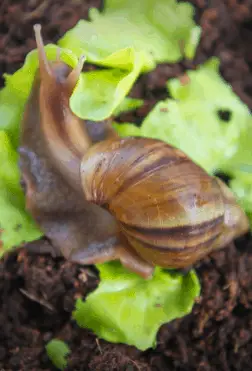
Appearance
Giant African land snails all have shells that are conical in shape. They are normally twice the height as it is broad. The shell can be both clockwise as counter-clockwise in coiling. However, most snails will have clockwise coiling. Except for their shell, they don’t have any tough structures. The body lacks any bones and is soft and flexible. They get their protection from their shell and they can retract their whole body inside its shell. The colour of the shell depends on the subspecies and diet, but all range from light orange to dark brown.
The body exists of three segments: The foot, the head and the visceral sax. The foot is the largest visible part of the body and with wave-like motion propels itself forward. The head contains two parts of stalks. The larger ones contain the eyes, the other two contain smell and touch. The visceral sac is the part that holds the shell. The foot secretes a slimy substance to make movement easier and make it stick to the surface.
The body colour can vary. Most common is the grey body colour, but some have a more creme brown or yellowish body colour. Within the pet industry are also snails that are sold that have a white body colour. This is a special breed of this species but it is not a natural occurrence of body colour.
Species of giant African land snails
The giant African land snail is the common name of several species of unusually large terrestrial snails within the family Achatinidae. The most commonly known of them is the giant African snail (Achatina achatina), which are also known by the names agate snail or Ghana tiger snail. The other two are the giant east African snail (Lissachatine fulica) and the giant west African snail (Archachatina marginata).
All of them are quite commonly kept and very popular as pets, however, Achatina achatina is most kept because of their enormous size. They can grow the biggest of them all with recorded shells of over 30cm (12″). In the pet industry, these different species are often sold by the same commonly used name ‘giant African land snail’.
Behaviour, temperamant and handling
Giant African land snails are more active during the night and will rest more during daylight. They often bury themselves beneath the ground as a way of protection from predators.
Their behaviour repertoire exists of moving, eating and resting. If you have luck, you can also see them mate, but they do that mostly at night.
They move by making wave-form propulsion with their foot muscle, slowly going forwards. Normally you can’t see this motion, and it looks just like the slide forward without any muscle movement. See the video of how this movement looks.
In captivity, land snails can be kept in large groups, but naturally, they are not social animals. They don’t have any care for their offspring, and after laying eggs, they immediately leave. Except for breeding, they do not interact with others. So they can live perfectly alone and don’t need a buddy in their enclosure.
You can handle giant African snails with care. It is best to make your hands wet so they can more easily crawl on your hand. However, be aware that wet hands also make it more slippery. Make sure they don’t fall off and try to support their large and heavy shell.
Never grab and pull a snail on his shell. You could damage the shell or pull off the shell partly or entirely. Next to that, the front part of the shell is the newest and therefore most fragile. Especially stay of that part of the shell so you don’t damage it.
Always wash your hands before and after you handled snails. Afterwards, rinse all the slimy stuff off your hands and use disinfectant to kill any bacteria or parasite.
Housing requirements for giant African land snails
The first key element for keeping giant African land snails is a proper tank. In this section, we discuss all you need to know about the housing requirements for giant snails and how to set up the habitat for your animals.
Type and size of the enclosure
The most popular choice to keep giant snails is either a fish tank or a plastic storage box. As long as your enclosure has is made out of plastic or glass, and have a lid on it, it is probably suitable for keeping snails. Wood and netting enclosures are not suitable. In the case of wood, they can eventually eat through it and with the humid environment will quickly rot away. Netting enclosures are not suitable for them to climb and it is difficult to create a humid environment.
Fish tanks are in that case most suitable. They have lids on them and often good ventilation. Glass aquariums and tanks are more pleasing to have a prominent place in your room. They just look prettier. Especially compared to a plastic storage box. Glass also is less susceptible to scratches and the animals are better visible.
A more expensive option, but nevertheless very good quality enclosures are reptile terrariums. These have very good ventilation capacity and a large benefit is that it not only opens at the top but have often doors on the front of the enclosure. This makes it much easier to feed your animals and clean your enclosure.
However, plastic storage boxes work great for keeping large snails and are rather cheap. Remember to buy one that is included with a lid. A downside is that storage boxes don’t have ventilation, but because they are made out of plastic some ventilation holes are easily made. Just drill some little holes in the lid and you are good to go. You can also look for plastic reptile enclosures. There is a wide variety of them and probably one suitable to keep snails in it.
The size of the enclosure depends on how many snails you like to have. Your enclosure needs at least a size so that you can have a good layer of substrate, a water dish, food, a cuttlefish bone (more on that later) and that your snail still has enough space to crawl around and dig itself into the substrate. A good starting point is an enclosure with a floor space of 45cm by 30cm (18″x12″). Go for a height of at least 30cm (12″), but 45cm (18″) is a better option. However, this enclosure size is for 2 (adult) snails. If you like to keep more or want to breed with them in the future, you should have a larger enclosure, otherwise, it would quickly become overcrowded and can be very stressful for your snails.
Essential features of the enclosure
We already mentioned it is important to have an enclosure with good ventilation. Without proper ventilation the stagnant air becomes mouldy and the quality of the substrate will quickly go down. Always make sure there are little holes that provide enough fresh air but don’t let your snails escape.
Snails are extremely strong for their size. They can lift 10 to 50 times their own body weight. An unsecured lid is therefore easily lifted and they will crawl out quickly (well, quickly… you know what I mean). And when you breed, snails start out really small. These little baby snails are really escaping artists.
Snails like smooth surfaces, but be careful with sharp edges. Although snails are soft and flexible, they can damage themselves on sharp stuff in the enclosure.
Make sure your enclosure has easy access so that you can comfortably provide food, refresh the water dish and clean the sides of the enclosure. We will discuss cleaning later, but it is good practice to have a backup enclosure (simple storage box) so when you extensively clean the enclosure you have something to temporarily house your snails.
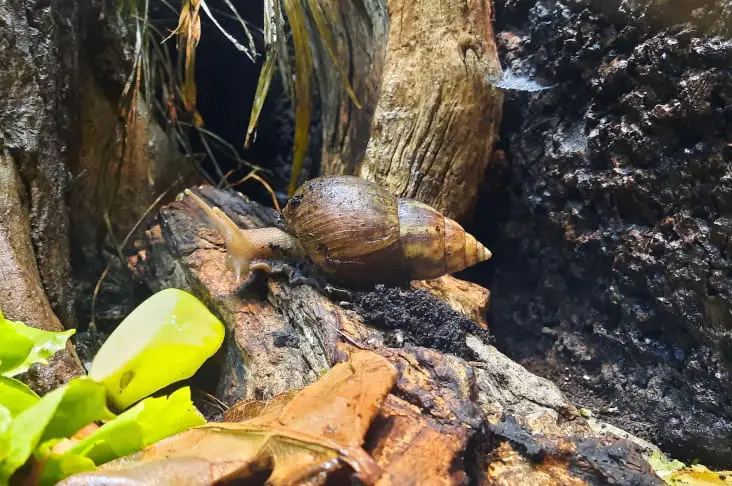
The substrate
The substrate is an important part of the environment for giant snails. They use the substrate to burrow into, find shelter and lay their eggs. Besides that, the substrate regulates the humidity of your enclosure.
Your snail tank should have at least 5cm (2″) of a humid substrate. A proper substrate may exist of compost, coconut fibre (coconut coir), topsoil, leaves and sphagnum moss. These products are available at exotic pet shops, garden centres or online webshops. Make sure when you buy these products that they are 100% organic and don’t have any additives or chemicals.
Substrate should be regularly cleaned. Giant African land snails can make a pretty mess out of it. More on that in the section about cleaning. You could re-use some types of substrate, such as coconut fibre after baking it to kill bacteria, but personally, I’m not a fan of re-using the substrate. Because the substrate is quite cheap I just buy a new substrate to clean the enclosure.
Decorating your enclosure
Your enclosure is almost ready for your snails. The final touch is the decoration of the enclosure. You can add more complexity to your enclosure by adding wood pieces, branches like driftwood, artificial or live plants, and cork pieces. Don’t use artificial plants made out of silk. Snails will eat them or quickly destroy them.
If you collect leaves and branches out of nature it is best to freeze it for a couple of days before placing it into the enclosure. It will kill most bacteria, fungus and parasites. Don’t collect materials around farm fields. They may spray with pesticides or other chemicals, which can harm your snails. If you collect live plants from outside, try to wash them before you use them in your enclosure to remove any pests species.
Avoid any hard objects in the enclosure such as rocks, pebbles and terracotta pots. Snails can be clumsy and when they fall onto a hard object will break their shell.
In the next section, we will look at creating the perfect climate for your snails.
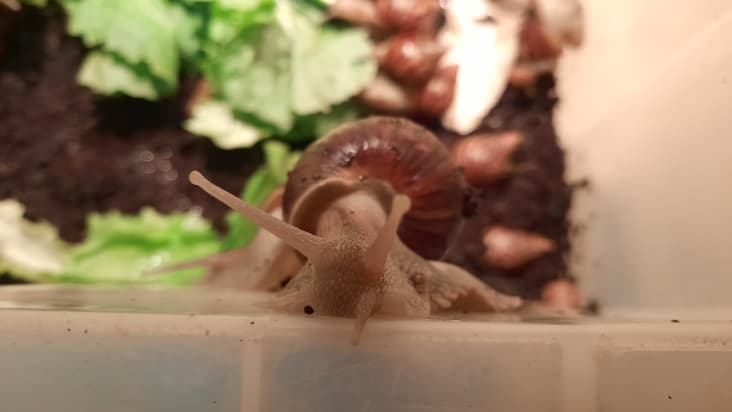
Environmental conditions to keep your giant land snails healthy and happy
Giant African land snails live originally in a tropical climate. Within your snail tank, you should mimic these conditions to provide them with an optimal habitat to keep them healthy and happy. A snail that is not kept in the correct conditions may seal the opening to its shell to wait for conditions to improve. If this happens make sure you check the environmental conditions of your enclosure and resolve any issues.
Temperature and heating
Giant snails are active between a temperature of 10°C and 30°C (50°F-86°F). They can even survive temperatures as long as they are above 2°C (36°F). With low temperatures, they will start hibernating inside their shell and slow down their metabolism. They can do so for several months without moving or eating any food. With really hot temperatures they may estivate to avoid these hot conditions. They will create a thin layer of mucus within the opening of their shell to keep the moisture inside their shell and not dry out. However, the most optimal temperature range is around 20°C to 25°C (68°F-77°F).
For most people, this means to lightly heat the enclosure (especially during the winter months). With a small heat pad, you already can create the perfect temperature. Don’t place the heat mat below the tank. This will cause the substrate to dry out rather quickly. Better would be to place the heat mat onto the backside of the enclosure.
You could also use a small light bulb of around 35W to heat the enclosure. Always place the lamp outside the enclosure because of the moisture and to avoid snails burning when they crawl onto the lamp. The benefit of a heat lamp is that you also create enough light in the enclosure and can regulate a normal light cycle.
Light and lightcycle
As we mentioned in the previous section, you can use a regular light bulb to create artificial light in the enclosure (use LED when you don’t want to heat the enclosure with your light). A light cycle of 12h day and 12h night is perfect.
Never place an enclosure in direct sunlight. Although natural light may be very beneficial to your snails, direct sunlight will heat up the enclosure to temperatures far above the optimal range. Long times of temperatures that are too high is very stressful for your snails and potentially lethal. Look for a location so they only have indirect sunlight.
However, many places don’t have a light cycle of 12h:12h, so artificial light is also beneficial.
Humidity and spraying
Giant land snails like humid environments and you should keep the substrate moist at all times, but be aware not to make it soggy. Moss and leaves help to keep your enclosure humid and keep the substrate damp.
You can moisten the substrate by lightly spraying water onto it. Use water that is at room temperature so the animals and the enclosure don’t cool of too much. If you live in an area where they add chemicals to tap water, it is best to use osmosis water, water from a bottle, or water that is cooked.
Besides spraying the enclosure, it is good practice to keep a water bowl in the enclosure for your snails to bathe and to keep the enclosure humid. You can get nicely decorated water bowls at reptile shops or at online webshops, but a simple plastic bowl is already enough.
Some keepers use cork plates to decorate one or more sides of the tank. Besides that it looks pretty, cork has the ability to soak up water and release it slowly to keep the enclosure humid. When you want to use cork plates, find the ones that are not treated with any chemicals. There are also cork plates available for construction (isolation), but often they are treated with fire-resistant chemicals which in turn are unhealthy for your snails.
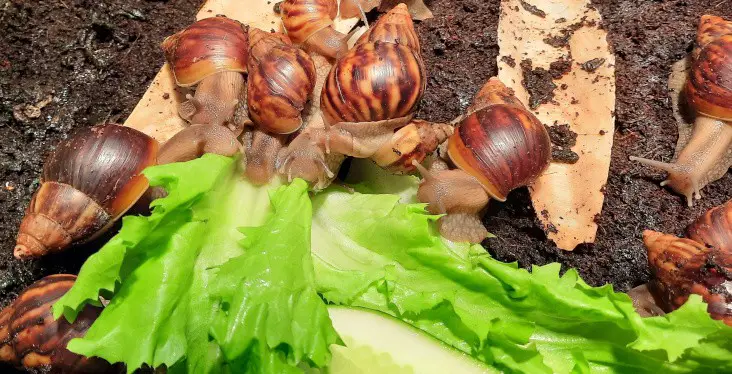
Feeding practice of giant African land snails
Giant African land snails are herbivores. They only eat plant material. It is good practice to provide a wide range of food products so they have a complete diet with all the minerals and vitamins they need. The food should be fresh and cleaned. They prefer foods and plants that contain a lot of moisture, but be aware that moisture food also does not contain many nutrients (for example cucumber or lettuce).
A good practice is to mash different products together with fish flakes, crushed dog pellets and/or calcium powder to make a paste that contains a large number of nutrients. Add enough water to make it a consistent paste, but not too much.
Foods that you must avoid is any processed foods, onions, and other foods that contain a lot of salt. Canned and conserved foods often contain too much salt for snails. This will make them ill or can even be lethal.
Calcium is an important part of their diet. It keeps their shell strong, healthy and helps them grow. You could add calcium powder over the food but is also good to provide cuttlefish bones at all time. They like to scrub off the softer parts of it to collect enough calcium. Cuttlefish bones are available at almost any pet shops because it is also used for birds.
Feed them the amount that is eaten within 24 to 48 hours. Always remove uneaten food items because it will quickly mould in the humid and warm environment. I like to feed them daily with fresh foods and adjust the amount of food to what they eat in one day. Food can be provided onto the substrate or you can use a food dish (especially useful when you want to provide them mashed/pasted food. I use reptile dishes, because they look more esthetic and have small edges for them to climb in and out, but any shallow dish will work.
Snails can get a lot of moisture out of their food, so it is not strictly necessary to provide them with a water dish. But as mentioned before, they like to bathe in water (and at the same time drink from it) and it keeps the humidity steady. So I can recommend providing a shallow dish with room temperature water in it. Refresh the water in it daily.
Below we list the foods that are suitable for giant snails (bold items seem to be favoured by snails, but do not limit the diet only to these products):
- Apple
- Artichoke
- Banana
- Basil
- Beans
- Blueberries
- Cabbage
- Carrot
- Cauliflower
- Celeriac
- Cherry
- Chicory
- Clover
- Courgette
- Cress
- Cucumber
- Dandelion leaves
- Dog pellets
- Endive
- Fish food flakes
- Lettuce
- Kale
- Kiwi
- Mango
- Marrow
- Mushrooms
- Nettle
- Passion fruit
- Peach
- Peas
- Pears
- Pepper
- Plum
- Potato (peelings)
- Pumpkin (seeds)
- Raisins
- Spirulina
- Strawberries
- Sweetcorn
- Sweet potato
- Tangerine
- Tomato
- Turnip
- Watermelon
Cleaning routine
The snail tank should be cleaned frequently. Snails can make a mess of it and the droppings and uneaten food parts are a breeding ground for bacteria and fungus.
Remove uneaten food parts daily or every other day. Rotten foods are unhealthy to your snails and can make your snails ill. Also, rotten foods will accelerate the process of bacteria and fungus growth.
The enclosure should be cleaned once a week, where you remove the very dirty substrate spots and clean the sides of the tank. For cleaning, only use tap water. Any detergents do a lot of harm to your snails.
Once a month to two months (depending on the number of snails and size of your tank) you should refresh the substrate for a new substrate. The substrate will be versatile with snail poop and wet clumps of dirt. Remove all the snails into a temporary tank so you can clean the enclosure from top to bottom. Even with a large cleaning session, it is best not to use any chemicals. If the stains are too much, use biodegradable detergents and thoroughly rinse it with water afterwards, so no chemicals are left behind when placing back your snails.
Before and after cleaning the enclosure, also wash your hands thoroughly. After cleaning the enclosure, also use disinfectant to kill any bacteria and parasites on your hands.
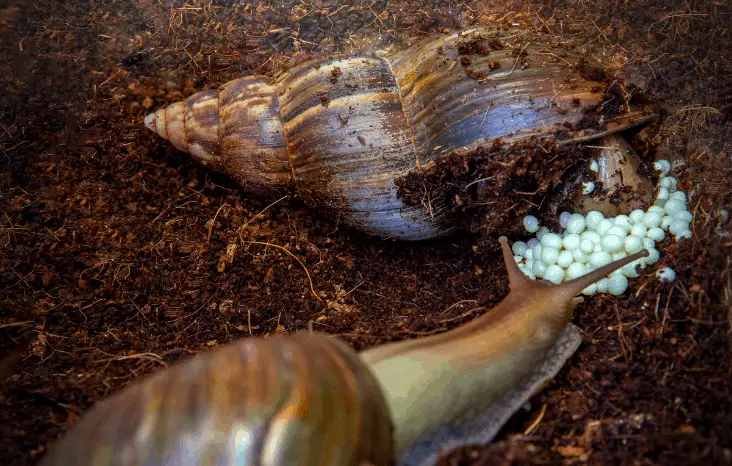
Breeding giant African land snails
Giant African land snails are rather easy to breed. They can already start breeding after six months. They will lay white or yellowish eggs in clutches of 30 up to 1000 eggs, although in captivity it is often more on the lower site. Be ready that when you start breeding you’ll soon have (too) many snails.
These snails are hermaphrodites — meaning that one individual has both male and female organs. That doesn’t mean they self-fertilise eggs (although there are reports they can), but as soon as you have to snails they can breed.
They don’t require much attention for them to start reproducing. If they are happy and healthy, they probably will breed. In good condition, around 90% of the eggs will hatch and will survive until adulthood.
You could separate the small baby snails from the parents to increase survival (they won’t be damaged by the adults), but because there will be so many offspring it is not necessary. Probably you end up with too many snails in no time. The challenge is that they breed so well you’ll end up with more snails that you can house or re-home elsewhere.
It is good practice to remove every unwanted egg if you don’t or can’t have more snails. Try to minimize the breeding, and only start breeding to supply your own colony. Remove and freeze or crush the eggs so they won’t hatch.
Under no circumstances you should release these snails into the wild. It is illegal to release exotic pets outside and in many countries, these snails damage the surrounding flora and fauna. Therefore several countries have banned this species to be kept as pets. Make sure that if you are allowed to keep these snails as pets, you’ll never release them where they shouldn’t live and survive.
Other bugs you can keep as a pet
Although cockroaches are amazing pets, there are many other bugs that make great pets too. Check out the bugs below, maybe you find them even more interesting to keep.
– Praying mantises
– Stick insects
– Millipedes
– Beetles
– Ant colony
– Tarantulas
Share this page!

